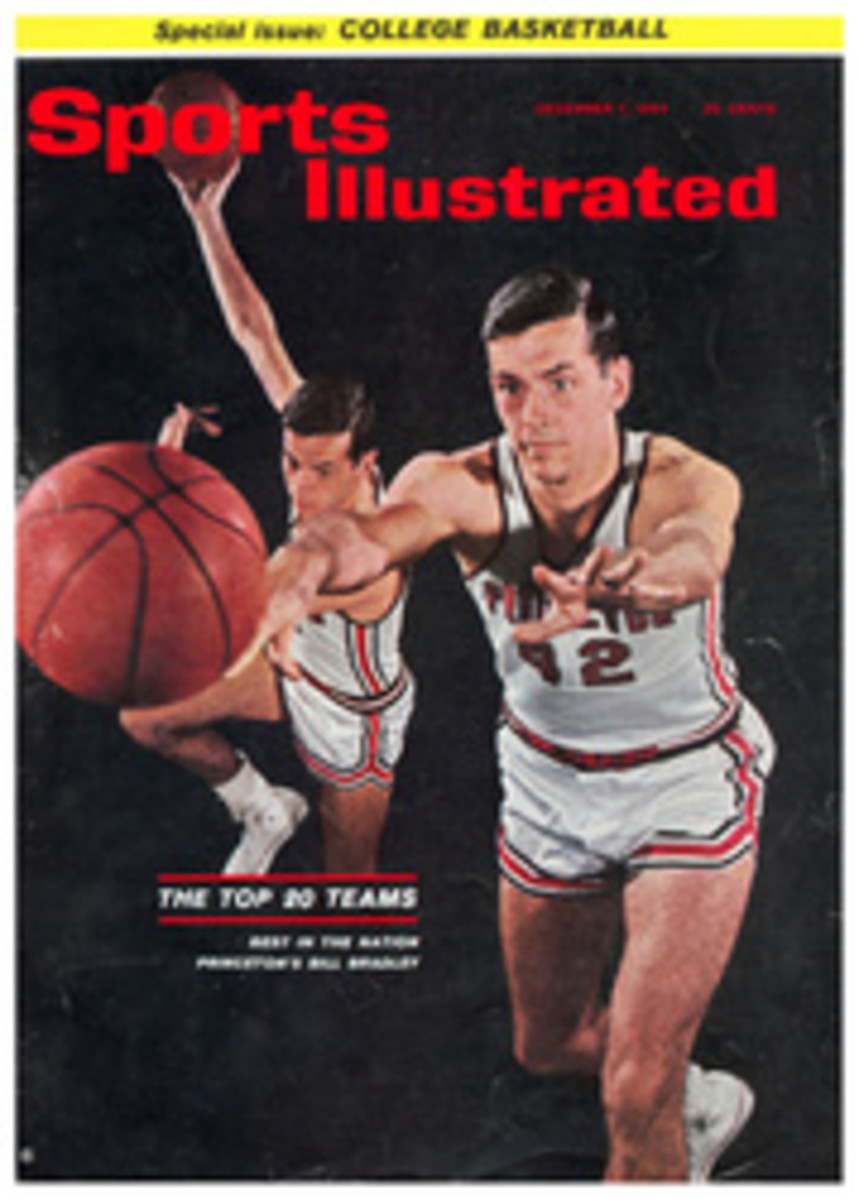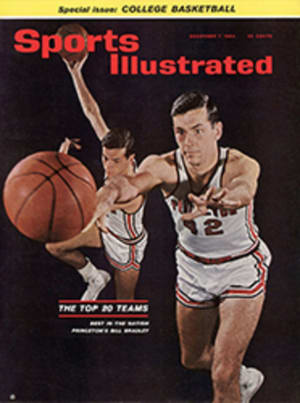
Great Asterisk Football Game
Back in 1896 when football looked more like a 22-man tag-team match, Boston College and Holy Cross played the first two games of a series that has since included 60 games in all and has developed into one of New England's top rivalries. The first game between the two Jesuit schools was played in Worcester, Mass., home of Holy Cross, and was won by BC, 6-2. The second game, played a week later in Boston, was a different story. When the game was over both teams claimed the victory, and to this day record books, college historians and even newspaper accounts disagree. The nearest either side will come to accord is to mark the score with an asterisk, coldly observing at the bottom of the table: *victory disputed.
Boston College had been playing organized football for three years before it added Holy Cross to its schedule. The Crusaders of Holy Cross, on the other hand, had just formed a team in 1896, and their coach was Dr. A. C. N. Peterson. BC had no hired coach that year, so its captain, Joe Walsh, acted as principal organizer. In those days football was a murderous affair. Rules, equipment, strategy and officiating were, by present standards, primitive. Teams relied on three stock plays—a line buck, an end run and a punt. The flying wedge had been outlawed that same year, but the mass attack, sometimes called the ' "turtle back," was still popular. Ten men formed in a mass several yards behind the scrimmage line. The ball was snapped back and disappeared into the middle of the mass. Soon the whole group would start running together, forcing opponents to tackle anybody and everybody until they found the one with the ball. In a trick variation of this, all but one of the bunch would move to the side of the field, as in a wedge formation, with one man bent over and apparently carrying the ball. While the opponents chased him, the unnoticed man on the ground, who all the time had the ball concealed under him, got up and ran down the other side of the field.
Most of the players of that era wore turtleneck sweaters and pants with quilting on the front of the thighs. Some used a combination one-piece canvas suit, though moleskin had begun to replace this. The typical player wore his hair long. No substitutions were allowed except for disqualified or injured players, but once taken out they could not return to the game. It took virtually a state of unconsciousness to get them out.
Three tries instead of four were allowed for a first down, and five yards, not 10, was the distance required. Interlocked arms, pushing and pulling were legal. Hughie McGrath, Boston College's 130-pound fullback, had a leather strap sewed to the seat of his trousers by which he was lifted and thrown bodily over the scrimmage line. There was no neutral zone between the opposing lines; the men were nose to nose, and the instant the ball touched the ground it was in play.
It was the officiating, however, that was bizarre. There was no governing body to test the knowledge of the men who called the plays and, as a result, they were notably lax on rules and often prejudiced since many worked in games played by their own schools. On a close play it was not an uncommon sight to see the referees toss a coin to decide the question. Scoring was different, too, with the foot playing a much larger role than today. In 1896 a touchdown counted four points, a conversion two points, a field, goal five and a safety two.
Two men shared the referee's job on November 14, 1896 for the second and controversial BC-HC game. One was Harry L. Dadmun, a graduate of Worcester Tech and a member of the Worcester Athletic Club, who was considered one of the East's outstanding football officials. He was 27 at the time. The other referee was Thomas C. Clark-son, who was attending Boston University's medical school. The two agreed to divide their authority, with Dadmun running the first half of 20 minutes and the young Clarkson taking over for the second half where, ultimately, he was to become the central figure in the dispute. Little is known of Clarkson other than his one-year attendance at BU. Dadmun, who died in 1957 at the age of 88, was a reporter with The Worcester Telegram, and it is mainly his account of the game that appears here.
A bleak wind was blowing down the field that Saturday at the South End grounds. There was snow on the ground and the mud was inches deep. The crowd numbered about 500. Holy Cross sported a living legend in its own backfield, the wonderfully gifted Indian athlete from Old Town, Me., Louis Francis (Chief) Sockalexis. Just one year later, the star halfback and brilliant baseball player signed with the Cleveland Indians, and he played three years in the major leagues, winding up with a .307 batting average.
The game began at 3 p.m., and right from the start the ball was kicked back and forth by the two teams, who found the slippery pigskin too difficult to move on the wet field. Boston College worked a bluff punt with a crisscross to move the ball deep into Holy Cross territory. Left Tackle Jim Landrigan sprinted around George Linehan's end for the longest run of the game, about 60 yards. Then he and Bob Croker, the right end, took turns carrying the ball until it was across the Holy Cross goal line. Bill Lyons missed the kick, and after 10 minutes the score read: BC 4, HC 0. There was no more scoring in the first half.
Holy Cross dominated play in the second half with Ed Kelly, the right tackle, running the ball most of the time until he scored to tie the game, 4-4. The conversion attempt involved quite a fancy piece of strategy, as many did in those days, since the ball was always put in play directly from where the touchdown was scored.
But the angle was too sharp for a good try at kicking the ball over the goal posts and, following the rules of the day, Fullback Ed Hickson punted the ball backward. Jim Campbell, the snapper back or center, made a fair catch. The angle was still a poor one, but against a strong wind Linehan came through with an outstanding kick to put Holy Cross in the lead, 6-4.
Sockalexis and Kelly starred for the Crusaders at this point, tackling and running magnificently. Captain John Finn and Left Tackle John Dooley also rushed Boston College back on its heels. With two and a half minutes remaining in the game, Walsh of the Eagles and one of the Holy Cross linemen tangled after the whistle had blown. A fight broke out. All the players joined in, followed by the spectators who came right down onto the field. The air was filled with flying canes, fists and hats. It took five policemen to get the mob in hand.
During the battle, the ball was picked up by a Boston College player and run over the Holy Cross line. Walsh claimed a touchdown, but Referee Clarkson ordered the ball brought back to the position it held after the last play before the riot. Walsh argued vehemently, but Clarkson stood firm. Walsh ordered his team off the field and refused to play. While Clarkson tried to persuade the Boston College players to return, Captain Finn of Holy Cross demanded a decision on the disputed play.
Clarkson made one more appeal to Walsh, but the Eagle captain still declined. Clarkson ruled: "On the ground that the Boston College players refuse to continue the game, I award the game to Holy Cross, the final score being 6-4 in their favor." Captain Finn announced the referee's decision to his players, a cheer was given for the Boston College students and the Holy Cross players got into their bus and went to their hotel nearby. Most of the spectators left the field, too, believing that the game was over and Holy Cross had won, 6-4.
But the stragglers who stayed to argue or applaud were rewarded with some new excitement. About five minutes after Holy Cross had been awarded the game and left the field, an outsider called Captain Walsh to his side. Whatever passed between them is unrecorded, but the Eagle captain came back to the crowd and informed the referee that he was ready to continue the game and would have his players ready immediately.
Referee Clarkson sent a messenger out into the street for Captain Finn. The messenger returned and said that Finn refused to bring his team back to the field. When Clarkson was told of this, he immediately requested the Boston College players to line up, and after he had blown his whistle the Boston boys trotted toward the unguarded Holy Cross goal. Art White carried the ball on this play, and when he had touched it down behind the Holy Cross goal. Referee Clarkson gave the Boston players a touchdown and then declared that the score of the game was 8-6 in favor of the home team.
Of this last play, the Holy Cross team knew nothing until informed of it by a reporter. When asked if he had met a messenger from Referee Clarkson, Captain Finn insisted he had not and was shocked that the referee, after having made one decision, should then make another in the absence of one of the teams after the game had officially ended.
With all the fighting and animosity caused by this game, it was feared that the friendly relations that had existed between the brother schools would end and their ties would be severed. Not so. The next year found the two rivals once again squaring off on the gridiron, with Holy Cross winning, 10-4.
But the series was forever after haunted by the controversy over the great asterisk football game of 1896.
PHOTO

